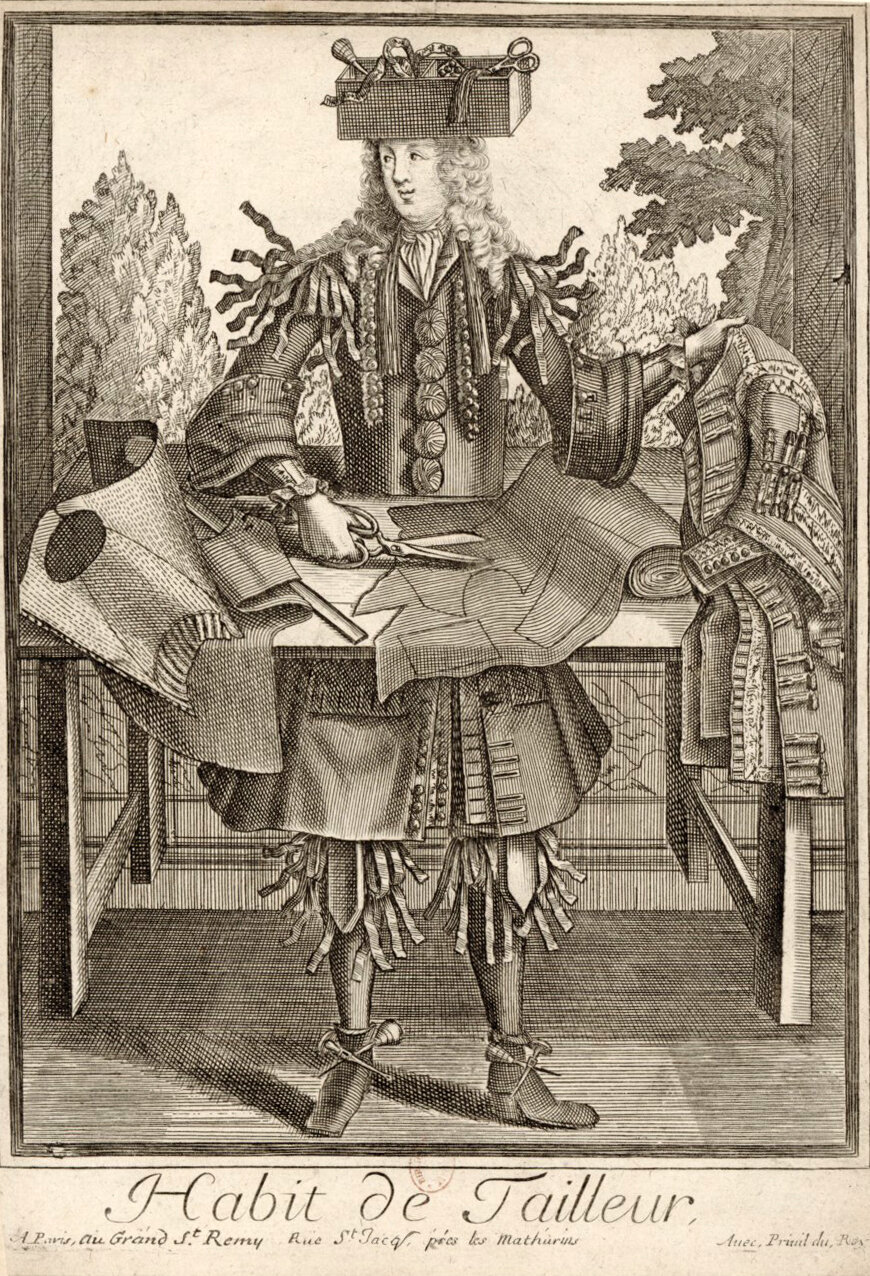Tailor
Was your ancestor a "tailleur d'habits", or tailor? Learn what this occupation was like in New France, Québec and Canada.
Cliquez ici pour la version française
Le Tailleur d’habits | The Tailor
"Habit de tailleur", digital image of a 17th century engraving, Bibliothèque nationale de France (https://gallica.bnf.fr).
It was in the year 1588 that the occupation of “tailleur d’habits”, or tailor, appeared in France. The “tailleur d’habits” referred to a tailor who made all items of clothing for men and women. In 1675, Louis XIV decided that women could also make clothing, but that they would be called “couturières”, or seamstresses, have their own guild, and could only make clothes for women and girls.
In a nutshell, the tailor would cut, sew, make & sell clothing. To cut clothing meant to cut from a piece of fabric the pieces necessary to make an item of clothing, and give it the required width and length, so that it could be worn by the person having it made. In order to cut the fabric, the tailor would spread out the fabric over a table. As most pieces of clothing had to be doubled (right side and left side), the tailor would usually double the material to cut two pieces at once. He used a pattern or model of the piece he wanted to cut, then used a large pair of specialty scissors to cut the fabric around the pattern, using precision to make sure he had enough cloth for all the pieces he needed. This cloth was normally supplied by the client. Once the tailor had all the pieces he needed, he could then sew the garment together, making alterations as needed until the item of clothing was completed. The tailor could sew the clothing himself, or outsource that work to a seamstress.
"Le tailleur = Der Schneider" (the tailor), digital image of an 1847 drawing by Jean Frédéric Wentzel, Bibliothèque nationale de France (https://gallica.bnf.fr).
"Tailleur d’habits, outils" (the tailor’s tools), digital image of a drawing (artist unknown) appearing in the 1763 Encyclopédie de Diderot (http://encyclopédie.eu).
Did you know that in French there’s an expression “s'asseoir en tailleur”, which translates as “to sit like a tailor”? The image on the right illustrates where the expression comes from. It simply means to sit cross-legged.
Persons who exercised this profession: Thomas Barthélémy, Jacques B(e)audu, Louis Brien dit Desrochers, Claude Bouchard, Élie Boucher, Alexis Brunet dit Dauphiné, Joseph Capellier, André Carrière, Paul Caty dit Laiguille, Albert-Guilain Cauchy de la Couture, Laurent Costille, Pierre Dagenais/Dagenet dit Lépine/Leprince, Jean Baptiste Desmarchais dit Persigny, Louis Drolly, Guillaume Dupas, Guillaume Dupont dit Leblond, Joseph Durocher/Duroché, Joseph Fourré dit Lespérance, Jacques Fuchs, Joseph Gaudin/Godin dit Laulière, Guillaume Gournay/Gourné dit Latour, Rémy le Graverant, Jean Baptiste Guillot/Guyot dit Lionois, Augustin Hébert, Nicolas Hubert dit Lacroix, Olivier Hugron/Hugueron, Charles Jobin, Jean Jobin, Mathurin Landry, Jacques Largeau dit St-Jacques, Guillaume Lecorgne, Denis Lemaître, Charles Marquis, Joseph Le Meunier, Melchior Michelet, Vincent Morant, Louis Moreau, Robert Mossion dit Lamouche, Pierre Navard, Thomas Pageau, Julien Perrault dit Rochefort, François Phénix dit Gruffat dit Dauphiné, Claude Philippeau(x), Jean Quenneville, Pierre Racine, Étienne Sarasin dit Lanoix, Adrien Sénécal dit Laframboise, Barthélémy Tesson.
Sources:
Denis Diderot, Encyclopédie ou Dictionnaire raisonné des sciences, des arts et des métiers. Tome quinzième, Sen-Tch (Paris, 1751-1765), digitized by the Bibliothèque nationale de France (https://gallica.bnf.fr/ark:/12148/bpt6k505471), 858-859.
Alfred Franklin, Dictionnaire historique des arts, métiers et professions exercés dans Paris depuis le treizième siècle (Paris, H. Welter, 1906), 677-678.
François-Alexandre-Pierre de Garsault, Art du tailleur : contenant le tailleur d'habits d'hommes, les culottes de peau, le tailleur de corps de femmes & enfants, la couturière & la marchande de modes (Paris, 1769), digitized by the Bibliothèque nationale de France (https://gallica.bnf.fr/ark:/12148/bpt6k108876j), 1-2.


